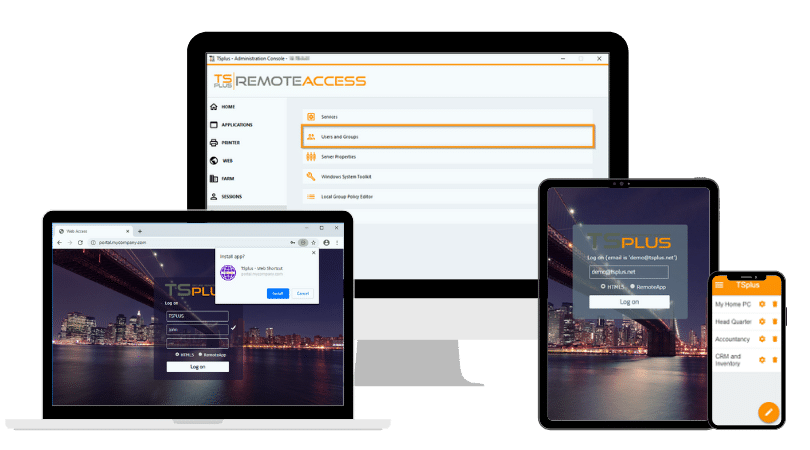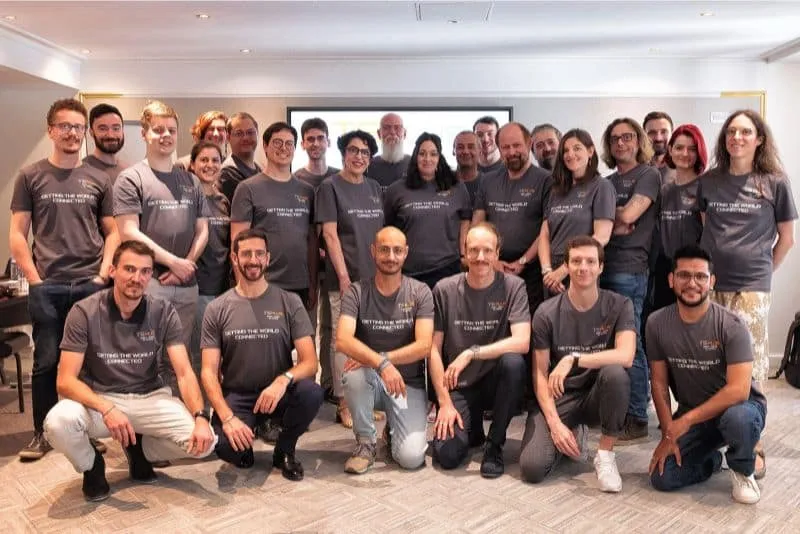"Remote Desktop Stuck on "Please Wait"?"
This article provides a deep technical dive into diagnosing and resolving this issue effectively, using command-line tools, services management, Group Policy adjustments, and session control strategies.
Would you like to see the site in a different language?
TSPLUS BLOG
Remote desktop sharing is an indispensable tool for IT professionals, allowing them to access and manage computer systems from remote locations. This capability is crucial in our increasingly digital and decentralized work environments, where direct physical access to devices is often impractical.
)
Remote desktop sharing enables precise control over a computer from a different location via the internet or a private network, playing a crucial role in everything from daily maintenance to urgent troubleshooting. This technology supports a wide range of IT activities, ensuring that professionals can address system needs without the constraints of physical proximity.
The core functionality of remote desktop technologies hinges on the seamless capture and transmission of graphical output from a host computer to a remote client. This is achieved through sophisticated encoding algorithms that minimize latency and bandwidth usage, ensuring that the graphical interface of the host system is replicated accurately and in real-time on the remote client's screen.
The client interacts with this interface via keyboard and mouse inputs, which are transmitted back to the host system, allowing for full control as if physically present.
These technologies often utilize advanced compression techniques to ensure that the screen updates are sent efficiently and without significant delays. Moreover, modern remote desktop solutions can intelligently adjust the quality of the stream based on the available network bandwidth, ensuring that the remote interaction remains fluid and responsive under varying network conditions.
This dynamic adjustment is critical for maintaining usability in environments with constrained network resources, making remote desktop sharing a versatile tool for IT professionals operating across a range of network settings.
Remote desktop sharing can be segmented into two primary categories, each serving unique needs within the IT landscape:
These applications are built with the explicit purpose of remote access and control. They often include features such as session encryption, real-time activity logs, and comprehensive administrative controls that allow IT managers to oversee and manage access permissions rigorously. Advanced dedicated solutions may also offer network configuration tools and automated system updates to maintain security and performance without manual intervention.
This type of remote desktop sharing leverages web technology to allow access via a browser, eliminating the need for installing client-side software. This method is particularly beneficial for organizations that require rapid deployment or temporary access, as it minimizes setup time and reduces compatibility issues across different operating systems. Web-based solutions can integrate seamlessly with cloud services, providing a scalable and flexible approach to remote desktop access.
Remote desktop sharing tools are integral in addressing the complex needs of IT operations, focusing on enhancing productivity and securing sensitive data.
These features collectively ensure that IT professionals can execute their responsibilities with enhanced efficiency and security, maintaining the integrity and stability of IT systems across organizations.
Remote desktop sharing serves as a versatile tool within IT management, facilitating a broad range of operations that improve efficiency and responsiveness.
Remote desktop tools expedite the resolution of technical issues by allowing IT personnel to access and troubleshoot systems without being physically present. This capability is crucial in minimizing response times and operational interruptions, which is especially important in high-stakes environments where uptime is critical.
These technologies enable IT staff to perform routine maintenance and management tasks from afar, such as updates, patch installations, and system monitoring. This remote capability ensures continuous system performance and stability without the need for onsite visits, reducing costs and streamlining operations.
By utilizing remote desktop sharing, IT departments can significantly boost their operational efficiency and responsiveness, adapting quickly to the needs of the business and maintaining continuous system integrity and performance.
Selecting the optimal remote desktop sharing software is vital to ensure an efficient and secure operation. This choice affects not only the immediacy and quality of support provided but also the overall security posture of the organization.
Selecting the right tool requires a careful balance of cost, functionality, and security to meet the specific needs of an organization, ensuring that all aspects of remote desktop interactions are streamlined and secure.
TSplus is designed with a focus on security, efficiency, and user-friendliness, offering a comprehensive solution for IT professionals. Our software supports all major operating systems and provides advanced security features, ensuring a safe and responsive remote desktop experience.
For more detailed information on how TSplus can support your IT operations with top-tier remote desktop solutions, visit our website.
Remote desktop sharing stands as a cornerstone technology for modern IT operations, enabling professionals to manage, troubleshoot, and maintain systems with unprecedented efficiency and from anywhere in the world. As businesses continue to embrace remote and hybrid work models, the importance of utilizing robust, secure, and user-friendly remote desktop solutions like TSplus cannot be overstated.

TSplus Remote Access Free Trial
Ultimate Citrix/RDS alternative for desktop/app access.Secure, cost-effective,on-permise/cloud
Simple, Robust and Affordable Remote Access Solutions for IT professionals.
The Ultimate Toolbox to better Serve your Microsoft RDS Clients.
 Get in touch
Get in touch